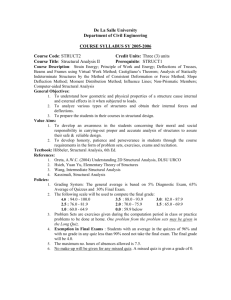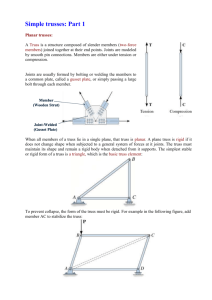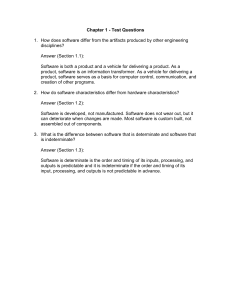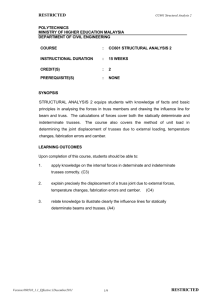Chapter 6: Analysis of Structures
advertisement
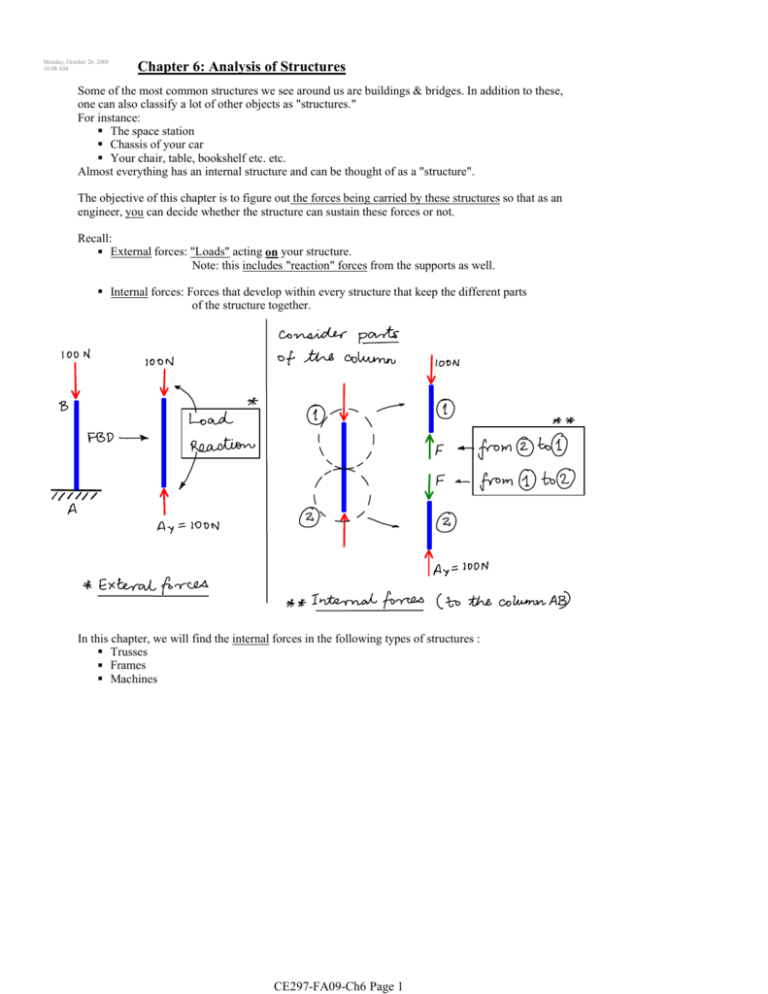
Monday, October 26, 2009 10:08 AM Chapter 6: Analysis of Structures Some of the most common structures we see around us are buildings & bridges. In addition to these, one can also classify a lot of other objects as "structures." For instance: The space station Chassis of your car Your chair, table, bookshelf etc. etc. Almost everything has an internal structure and can be thought of as a "structure". The objective of this chapter is to figure out the forces being carried by these structures so that as an engineer, you can decide whether the structure can sustain these forces or not. Recall: External forces: "Loads" acting on your structure. Note: this includes "reaction" forces from the supports as well. Internal forces: Forces that develop within every structure that keep the different parts of the structure together. In this chapter, we will find the internal forces in the following types of structures : Trusses Frames Machines CE297-FA09-Ch6 Page 1 Monday, October 26, 2009 10:11 AM 6.2-6.3 Trusses Trusses are used commonly in Steel buildings and bridges. Definition: A truss is a structure that consists of All straight members connected together with pin joints connected only at the ends of the members and all external forces (loads & reactions) must be applied only at the joints. Note: Every member of a truss is a 2 force member. Trusses are assumed to be of negligible weight (compared to the loads they carry) Types of Trusses Simple Trusses: constructed from a "base" triangle by adding two members at a time. simple simple NOT simple Note: For Simple Trusses (and in general statically determinate trusses) m: members r: reactions n: joints CE297-FA09-Ch6 Page 2 Wednesday, October 28, 2009 9:01 AM 6.4 Analysis of Trusses: Method of Joints Consider the truss shown. Truss analysis involves: (i) Determining the EXTERNAL reactions. (ii) Determining the INTERNAL forces in each of the members (tension or compression). Read Example 6.1 CE297-FA09-Ch6 Page 3 Friday, October 30, 2009 2:50 PM Exercise 6.13 Similarly, solve joints C, F and B in that order and calculate the rest of the unknowns. CE297-FA09-Ch6 Page 4 Friday, October 30, 2009 7:40 AM 6.5 Joints under special loading conditions: Zero force members Many times, in trusses, there may be joints that connect members that are "aligned" along the same line. Similarly, from joint E: DE=EF and AE=0 Exercise 6.32 Identify the zero-force members. CE297-FA09-Ch6 Page 5 Friday, October 30, 2009 7:50 AM 6.6 Space Trusses Generalizing the structure of planar trusses to 3D results in space trusses. The most elementary 3D space truss structure is the tetrahedron. The members are connected with ball-and-socket joints. Simple space trusses can be obtained by adding 3 elements at a time to 3 existing joints and joining all the new members at a point. Note: For a 3D determinate truss: n: joints 3n = m+r m: members r : reactions If the truss is "determinate" then this condition is satisfied. However, even if this condition is satisfied, the truss may not be determinate. Thus this is a Necessary condition (not sufficient) for solvability of a truss. Exercise 6.36 Determine the forces in each member. CE297-FA09-Ch6 Page 6 Similarly find the 3 unknowns FBD, FBC and BY at joint B. CE297-FA09-Ch6 Page 7 Monday, November 02, 2009 8:53 AM 6.7 Analysis of Trusses: Method of Sections The method of joints is good if we have to find the internal forces in all the truss members. In situations where we need to find the internal forces only in a few specific members of a truss, the method of sections is more appropriate. Method of sections: Imagine a cut through the members of interest Try to cut the least number of members (preferably 3). Draw FBD of the 2 different parts of the truss Enforce Equilibrium to find the forces in the 3 members that are cut. For example, find the force in member EF: Read Examples 6.2 and 6.3 from the book. Exercise 6.63 Find forces in the members EH and GI. CE297-FA09-Ch6 Page 8 CE297-FA09-Ch6 Page 9 Monday, November 02, 2009 8:53 AM 6.8 Compound Trusses; Determinate vs. Indeterminate Trusses. Trusses made by joining two or more simple trusses rigidly are called Compound Trusses. Partially constrained Overly constrained, Indeterminate Determinate Exercise 6.69 Classify the trusses as: Externally: Completely / Partially /Improperly constrained Internally: Determinate / Indeterminate. (if completely constrained) CE297-FA09-Ch6 Page 10 Wednesday, November 11, 2009 11:29 AM 6.9 - 6.11 Frames Frames are structures with at least one multi-force member, i.e. atleast one member that has 3 or more forces acting on it at different points. Frame analysis involves determining: (i) External Reactions (ii) Internal forces at the joints Note: Follow Newton's 3rd Law Frames that are not internally Rigid When a frame is not internally rigid, it has to be provided with additional external supports to make it rigid. The support reactions for such frames cannot be simply determined by external equilibrium. One has to draw the FBD of all the component parts to find out whether the frame is determinate or indeterminate. CE297-FA09-Ch6 Page 11 Friday, November 13, 2009 10:57 AM Example 6.4 Read examples 6.5 and 6.6 Exercise 6.101 Exercise 6.120 CE297-FA09-Ch6 Page 12 (a) (b) CE297-FA09-Ch6 Page 13 Wednesday, November 11, 2009 11:35 AM 6.12 Machines • Machines are structures designed to transmit and modify forces. Their main purpose is to transform input forces into output forces. • Machines are usually non-rigid internally. So we use the components of the machine as a free-body. • Given the magnitude of P, determine the magnitude of Q. Exercise 6.143 CE297-FA09-Ch6 Page 14 Monday, November 16, 2009 6:58 AM Determinate vs. Indeterminate Structures Structures such as Trusses and Frames can be broadly classified as: Determinate: When all the unknowns (external reactions and internal forces) can be found using "Statics" i.e. Drawing FBDs and writing equilibrium equations. Indeterminate: When, not all the unknowns can be found using Statics. Note: Some/most unknowns can still be found. Structures can also be classified as: Completely restrained Partially restrained Improperly restrained For trusses, we have been using "formulas" such as (2n = m+r) for planar trusses, and (3n = m+r) for space trusses to judge the type of structure. For frames, this can be much more complicated. We need to write and solve the equilibrium equations and only if a solution exists, we can conclude that the structure is determinate. Otherwise the structure may be partially constrained or indeterminate or both. IMPORTANT: One of the best ways (and mathematically correct way) to conclude determinacy of any structure is by using Eigen-values. Eigen-values tell us how many independent equations we have and whether can or can’t solve a system of equations written in the form of Matrices. [A] x = b To do this, Draw the FBDs of all rigid components of the structure Write out the all the possible equilibrium equations. Case 1: Number of Equations (E) < Number of Unknowns (U) <=> INDETERMINATE Case 2: Number of Equations (E) > Number of Unknowns (U) <=> PARTIALLY RESTRAINED Case 3: Number of Equations (E) = Number of Unknowns (U) Find the number of non-zero Eigen-values (V1) of the square matrix [A]. Find the number of non-zero Eigen-values (V2) of the rectangular matrix [A|b]. Case 3(a): V1 = E = U => Unique Solution DETERMINATE Case 3(b): V1 < E => Improperly constrained Number of INDEPENDENT equations = V1 < U Indeterminate & Partially constrained (i) V1 = V2 <U => Infinitely many solutions possible (ii) V1 < V2 => No solution exists Note: In this procedure, it is better not to reduce the number of unknowns or number of equations by using properties of 2-force or 3-force members. CE297-FA09-Ch6 Page 15 Examples: CE297-FA09-Ch6 Page 16

